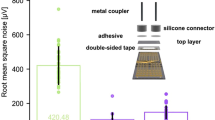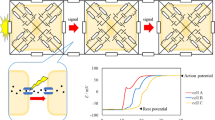Abstract
The signalling peptide bradykinin (BK) is implicated in inflammation and angiogenesis. It promotes fluid transport from blood vessels to interstitial space, and thus facilitates oedema formation. To clarify whether paracellular or transcellular pathways mediate this effect, we investigated the BK-stimulated fluid transport across endothelial monolayers in vitro by comparison of electrical and fluorescence methods. Electrical cell impedance sensing monitored a biphasic response of cell layers to BK with high time resolution: a short decrease (18%, 1 min) was followed by a more sustained increase in paracellular resistance (30%, 10 min). The two phases can be assigned to second messengers of the BK-signalling pathway: Ca2+ for the decrease and cyclic adenosine monophosphate for the rise of resistance, respectively. Despite tightening of the intercellular clefts, BK increased the fluid permeability by 39%, indicating transcellular fluid transport. Additionally, BK stimulated both in- and outwardly directed membrane trafficking as assessed by vesicular fluid uptake (by 49%) and secretion of von Willebrandt factor (by 85%). In conclusion, the combination of electrical and fluorescence data suggests that BK induces a shift from para- to transcellular fluid transport across endothelium.





Similar content being viewed by others
References
Abbott NJ (2000) Inflammatory mediators and modulation of blood–brain barrier permeability. Cell Mol Neurobiol 20:131–147
Adamson RH, Zeng M, Adamson GN, Lenz JF, Curry FE (2003) PAF- and bradykinin-induced hyperpermeability of rat venules is independent of actin–myosin contraction. Am J Physiol Heart Circ Physiol 285:H406–H417
Atia F, Zeiske W, Van Driessche W (1999) Secretory apical Cl- channels in A6 cells: possible control by cell Ca2+ and cAMP. Pflugers Arch 438:344–353
Bogatcheva NV, Garcia JG, Verin AD (2002) Molecular mechanisms of thrombin-induced endothelial cell permeability. Biochemistry (Mosc) 67:75–84
Borlongan CV, Emerich DF (2003) Facilitation of drug entry into the CNS via transient permeation of blood brain barrier: laboratory and preliminary clinical evidence from bradykinin receptor agonist, Cereport. Brain Res Bull 60:297–306
Catizone A, Chiantore MV, Andreola F, Coletti D, Medolago AL, Alescio T (1996) Non-specific pinocytosis by human endothelial cells cultured as multicellular aggregates: uptake of lucifer yellow and horse radish peroxidase. Cell Mol Biol (Noisy-le-grand) 42:1229–1242
Chen J, Braet F, Brodsky S, Weinstein T, Romanov V, Noiri E, Goligorsky MS (2002) VEGF-induced mobilization of caveolae and increase in permeability of endothelial cells. Am J Physiol Cell Physiol 282:C1053–C1063
Drexler HG, Quentmeier H, Dirks WG, Macleod RA (2002) Bladder carcinoma cell line ECV304 is not a model system for endothelial cells. In Vitro Cell Dev Biol Anim 38:185–186
Ek CJ, Habgood MD, Dziegielewska KM, Potter A, Saunders NR (2001) Permeability and route of entry for lipid-insoluble molecules across brain barriers in developing Monodelphis domestica. J Physiol 536:841–853
Emanueli C, Grady EF, Madeddu P, Figini M, Bunnett NW, Parisi D, Regoli D, Geppetti P (1998) Acute ACE inhibition causes plasma extravasation in mice that is mediated by bradykinin and substance P. Hypertension 31:1299–1304
Farmer PJ, Bernier SG, Lepage A, Guillemette G, Regoli D, Sirois P (2001) Permeability of endothelial monolayers to albumin is increased by bradykinin and inhibited by prostaglandins. Am J Physiol Lung Cell Mol Physiol 280:L732–L738
Feng D, Nagy JA, Hipp J, Pyne K, Dvorak HF, Dvorak AM (1997) Reinterpretation of endothelial cell gaps induced by vasoactive mediators in guinea-pig, mouse and rat: many are transcellular pores. J Physiol 504(Pt 3):747–761
Freay A, Johns A, Adams DJ, Ryan US, Van Breemen C (1989) Bradykinin and inositol 1,4,5-trisphosphate-stimulated calcium release from intracellular stores in cultured bovine endothelial cells. Pflügers Arch 414:377–384
Giaever I, Keese CR (1991) Micromotion of mammalian cells measured electrically. Proc Natl Acad Sci U S A 88:7896–7900
Golser R, Gorren AC, Leber A, Andrew P, Habisch HJ, Werner ER, Schmidt K, Venema RC, Mayer B (2000) Interaction of endothelial and neuronal nitric-oxide synthases with the bradykinin B2 receptor. Binding of an inhibitory peptide to the oxygenase domain blocks uncoupled NADPH oxidation. J Biol Chem 275:5291–5296
Gratton JP, Lin MI, Yu J, Weiss ED, Jiang ZL, Fairchild TA, Iwakiri Y, Groszmann R, Claffey KP, Cheng YC, Sessa WC (2003) Selective inhibition of tumor microvascular permeability by cavtratin blocks tumor progression in mice. Cancer Cell 4:31–39
Hashizume K, Black KL (2002) Increased endothelial vesicular transport correlates with increased blood–tumor barrier permeability induced by bradykinin and leukotriene C4. J Neuropathol Exp Neurol 61:725–735
Hippenstiel S, Witzenrath M, Schmeck B, Hocke A, Krisp M, Krull M, Seybold, J, Seeger W, Rascher W, Schutte H, Suttorp N (2002) Adrenomedullin reduces endothelial hyperpermeability. Circ Res 91:618–625
Hurst RD, Clark JB (1998) Alterations in transendothelial electrical resistance by vasoactive agonists and cyclic AMP in a blood–brain barrier model system. Neurochem Res 23:149–154
Johannes L, Lamaze C (2002) Clathrin-dependent or not: is it still the question? Traffic 3:443–451
Langer F, Morys-Wortmann C, Kusters B, Storck J (1999) Endothelial protease-activated receptor-2 induces tissue factor expression and von Willebrand factor release. Br J Haematol 105:542–550
Liebmann C, Graness A, Ludwig B, Adomeit A, Boehmer A, Boehmer FD, Nurnberg B, Wetzker R (1996) Dual bradykinin B2 receptor signalling in A431 human epidermoid carcinoma cells: activation of protein kinase C is counteracted by a GS-mediated stimulation of the cyclic AMP pathway. Biochem J 313(Pt 1):109–118
Lum H, Malik AB (1994) Regulation of vascular endothelial barrier function. Am J Physiol 267:L223–L241
Marceau F, Regoli D (2004) Bradykinin receptor ligands: therapeutic perspectives. Nat Rev Drug Discov 3:845–852
Marceau F, Sabourin T, Houle S, Fortin JP, Petitclerc E, Molinaro G, Adam A (2002) Kinin receptors: functional aspects. Int Immunopharmacol 2:1729–1739
Mcdonald DM, Thurston G, Baluk P (1999) Endothelial gaps as sites for plasma leakage in inflammation. Microcirculation 6:7–22
Minshall RD, Tiruppathi C, Vogel SM, Malik AB (2002) Vesicle formation and trafficking in endothelial cells and regulation of endothelial barrier function. Histochem Cell Biol 117:105–112
Moy AB, Winter M, Kamath A, Blackwell K, Reyes G, Giaever I, Keese C, Shasby DM (2000) Histamine alters endothelial barrier function at cell–cell and cell–matrix sites. Am J Physiol Lung Cell Mol Physiol 278:L888–L898
Neal CR, Michel CC (1995) Transcellular gaps in microvascular walls of frog and rat when permeability is increased by perfusion with the ionophore A23187. J Physiol 488(Pt 2):427–437
Oberleithner H, Ludwig T, Riethmuller C, Hillebrand U, Albermann L, Schafer C, Shahin V, Schillers H (2004) Human endothelium: target for aldosterone. Hypertension 43:952–956
Palade GE, Bruns RR (1968) Structural modulations of plasmalemmal vesicles. J Cell Biol 37:633–649
Paradiso AM, Cheng EH, Boucher RC (1991) Effects of bradykinin on intracellular calcium regulation in human ciliated airway epithelium. Am J Physiol 261:L63–L69
Schnittler HJ, Schneider SW, Raifer H, Luo F, Dieterich P, Just I, Aktories K (2001) Role of actin filaments in endothelial cell–cell adhesion and membrane stability under fluid shear stress. Pflügers Arch 442:675–687
Sharma HS (2000) A bradykinin BK2 receptor antagonist HOE-140 attenuates blood–spinal cord barrier permeability following a focal trauma to the rat spinal cord. An experimental study using Evans blue, [131]I-sodium and lanthanum tracers. Acta Neurochir Suppl 76:159–163
Tuma PL, Hubbard AL (2003) Transcytosis: crossing cellular barriers. Physiol Rev 83:871–932
Verkman AS (2002) Aquaporin water channels and endothelial cell function. J Anat 200:617–627
Vestweber D (2000) Molecular mechanisms that control endothelial cell contacts. J Pathol 190:281–291
Wegener J, Hakvoort A, Galla HJ (2000) Barrier function of porcine choroid plexus epithelial cells is modulated by cAMP-dependent pathways in vitro. Brain Res 853:115–124
Wegener J, Zink S, Rosen P, Galla H (1999) Use of electrochemical impedance measurements to monitor beta-adrenergic stimulation of bovine aortic endothelial cells. Pflügers Arch 437:925–934
Acknowledgments
The study was supported by Deutsche Forschungsgemeinschaft [SFB 629 (A6) and DFG Re 1284/2-1]. We thank Mrs. Marianne Wilhelmi for excellent technical assistance and Dr. S.W. Schneider, Dr. R. Ossig, Dr. T. Ludwig and C. Rommel for helpful discussions.
Author information
Authors and Affiliations
Corresponding author
Rights and permissions
About this article
Cite this article
Riethmüller, C., Jungmann, P., Wegener, J. et al. Bradykinin shifts endothelial fluid passage from para- to transcellular routes. Pflugers Arch - Eur J Physiol 453, 157–165 (2006). https://doi.org/10.1007/s00424-006-0121-2
Received:
Accepted:
Published:
Issue Date:
DOI: https://doi.org/10.1007/s00424-006-0121-2




